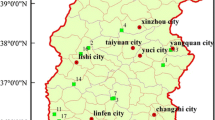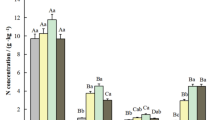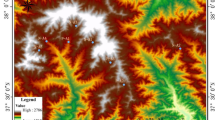Abstract
Populus davidiana, Leuchtenbergia principis, and Pinus tabulaeformis are important greening tree species with a cosmopolitan distribution. However, the stoichiometric characteristics and element reserves of stands of these three species are not particularly clear. In this study, we conducted a plot-level investigation of forest stands of these species in the loess area; these have been closed forest stands more than 28 years. Trees were sampled from an area of 50 m × 20 m (in 6, 8, and 9 plots, respectively), which was sufficient for shrub (2 m × 2 m), herbal species, and litter (1 m × 1 m) investigations. The C, N, and P concentrations and the C:N:P stoichiometry in five different soil layers (0–10 cm, 10–20 cm, 20–30 cm, 30–50 cm, and 50–100 cm) and in the leaves, stems, branches, and roots of the plants were examined. The soil element concentrations and density were affected by soil depth. The element content had a significantly negative correlation with soil depth, and element density differed significantly among the soil layers. A particular element in a particular organ differed significantly between the forest stands, and the same element in different organs of the same stand was also significantly different. The C, N, and P element reserves in the soil were considerably higher than in the plants. Our results indicate that there are different stoichiometric characteristics and element reserves of the three stands in a closed forest on the Chinese loess plateau, which may provide a reference when we develop and optimize the structure of forest stands.





Similar content being viewed by others
References
Bennett, E., & Elser, J. (2011). A broken biogeochemical cycle. Nature, 478(7367), 29–31.
Castle, S. C., & Neff, J. C. (2009). Plant response to nutrient availability across variable bedrock geologies. Ecosystems, 12, 101–113.
Cheng, B., Zhao, Y. J., Zhang, W. G., & An, S. Q. (2010). The research advances and prospect of ecological stoichiometry. Acta Ecologica Sinica, 30(6), 1628–1637.
Claudia Guidi, Lars Vesterdal, Damiano Gianelle, et al., 2014. Changes in soil organic carbon and nitrogen following forest expansion on grassland in the Southern Alps. Forest Ecology and Management.328, 103–116.
Cleveland, C. C., & Liptzin, D. (2007). C: N: P stoichiometry in soil: is there a “Redfield ratio” for the microbial biomass. Biogeochemistry, 85(3), 235–252.
Cross, W. F., Wallace, J. B., & Rosemond, A. D. (2007). Nutrient enrichment reduces constraints on material flows in a detritus-based food web. Ecology, 88, 2563–2575.
d’Annunzio, R., Zeller, B., Nicolas, M., Dhote, J. F., & Saint-Andre, L. (2008). Decomposition of European beech (Fagus sylvatica) litter: combining quality theory and N-15 labelling experiments. Soil Biology and Biochemistry, 40, 322–333.
Du, E. Z., Liu, X. Y., & Fang, J. Y. (2014). Effects of nitrogen additions on biomass, stoichiometry and nutrient pools of moss Rhytidium rugosum in a boreal forest in Northeast China. Environmental Pollution, 188, 166–171.
Elser, J. J. (2009). Andersen T, Baron J S, Bergstrom A K, Jansson M, Kyle M, Nydick K R, Steger L, Hessen D O. Shifts in lake N ∶P stoichiometry and nutrient limitation driven by atmospheric nitrogen deposition. Science, 326(5954), 835–837.
Elser, J. J., Dobberfuhl, D. R., Mackay, N. A., & Schampel, J. H. (1996). Organism size, life history, and N: P stoichiometry. Bioscience, 46, 674–684.
Elser, J. J., Sterner, R. W., Gorokhova, E., Fagan, W. F., Markow, T. A., Cotner, J. B., Harrison, J. F., Hobbie, S. E., Odell, G. M., & Weider, L. J. (2000). Biological stoichiometry from genes to ecosystems. Ecology Letters, 6, 540–550.
Escalante, A., & Farmer, J. D. (2005). Effects of phosphorus enrichment and grazing snails on modern stromatolitic microbial communities. Freshwater Biology, 50, 1808–1825.
Fedrigo, M., Kasel, S., Bennett, L. T., et al. (2014). Carbon stocks in temperate forests of south-eastern Australia reflect large tree distribution and edaphic conditions. Forest Ecology and Management, 334, 129–143.
Feller, I. C., Lovelock, C. E., & Mckee, K. L. (2007). Nutrient addition differentially affects ecological processes of Avicennia germinans in nitrogen versus phosphorus limited mangrove ecosystems. Ecosystems, 10, 347–359.
Fitter, A., & Hillebrand, H. (2009). Microbial food web structure affects bottom up effects and elemental stoichiometry in periphyton assemblages. Limnology and Oceanography, 54, 2183–2200.
Güsewell, S., & Gessner, M. O. (2009). N: P ratios influence litter decomposition and colonization by fungi and bacteria in microcosms. Functional Ecology, 23, 211–219.
Güsewell, S., Koerselman, W., & Verhoeven, J. T. A. (2003). Biomass N: P ratios as indicators of nutrient limitation for plant populations in wetlands. Ecological Applications, 13, 372–384.
Hall, S. R., Smith, V. H., Lytle, D. A., & Leibold, M. A. (2005). Constraints on primary producer N: P stoichiometry along N:P supply ratio gradients. Ecology, 86, 1894–1904.
Han, W. X., Fang, J. Y., Guo, D. L., & Zhang, Y. (2005). Leaf nitrogen and phosphorus stoichiometry across 753 terrestrial plant species in China. New Phytologist, 168(2), 377–385.
He, J. S., Fang, J. Y., Wang, Z. H., Guo, D. L., Flynn, D. F. B., & Geng, Z. (2006). Stoichiometry and large-scale patterns of leaf carbon and nitrogen in the grassland biomes of China. Oecologia, 149(1), 115–122.
He, J. S., Wang, L., Flynn, D. F. B., Wang, X. P., Ma, W. H., & Fang, J. Y. (2008). Leaf nitrogen: phosphorus stoichiometry across Chinese grassland biomes. Oecologia, 155(2), 301–310.
Hessen, D. O., Leu, E., Faerovig, P. J., & Petersen, S. F. (2008). Light and spectral properties as determinants of C: N: P-ratios in phytoplankton. Deep-Sea Res Part II, 55, 2169–2175.
Jeyasingh, P. D., Weider, L. J., & Sterner, R. W. (2009). Genetically-based trade-offs in response to stoichiometric food quality influence competition in a keystone aquatic herbivore. Ecology Letters, 12(11), 1229–1237.
Jobb Agy, E. G., & Jackson, R. B. (2000). The vertical distribution of soil organic carbon and its relation to climate and vegetation [J]. Ecological Applications, 10(2), 423–436.
Luo, Y.Z., Zeng, T., Dong, W., et al. (2013). Research of ecological stoichiometry of plant community in alpine Kobresia meadow[J]. Chinese Journal of Grassland, 35(3):92–96.
McGroddy, M. E., Daufresne, T., & Hedin, L. O. (2004). Scaling of C :N : P stoichiometry in forests worldwide: implications of terrestrial Redfield-type ratios. Ecology, 85(9), 2390–2401.
Miller, A. J., Amundson, R., Burke, I. C., et al. (2004). The effect of climate and cultivation on soil organic C and N. Biogeochemistry, 67, 57–72.
Ren, S. J., Yu, G. R., Tao, B., & Wang, S. Q. (2007). Leaf nitrogen and phosphorus stoichiometry across 654 terrestrial plant species in NSTEC. Environmental. Science, 28(12), 2665–2673.
Smart, D. R., Ritchie, K., Bloom, A. J., & Bugbee, B. B. (1998). Nitrogen balance for wheat canopies (Triticum aestivum cv. Veery 10) grown under elevated and ambient CO2 concentrations. Plant, Cell and Environment, 21, 753–763.
State Forestry Administration (1999). Forest soil analysis method(the forestry industry standard of the People's Republic of China)[S]. Beijing: Standards Press of China.
Sterner, R. W., & Elser, J. J. (2002). Ecological stoichiometry: The biology of elements from molecules to the biosphere. Princeton: Princeton University Press.
Sterner, R. W., & George, N. B. (2000). Carbon, nitrogen, and phosphorus stoichiometry of cyprinid fishes. Ecology, 81, 127–140.
Sterner, R. W., & Hessen, D. O. (1994). Algal nutrient limitation and the nutrition of aquatic herbivores. Annual Review of Ecology and Systematics, 25, 1–29.
Tadesse, G., Zavaleta, E., & Shennan, C. (2014). Effects of land-use changes on woody species distribution and aboveground carbon storage of forest-coffee systems. Agriculture, Ecosystems and Environment, 197, 21–30.
Volkova, L., & Weston, C. J. (2015). Carbon loss from planned fires in southeastern Australian dry eucalyptus forests. Forest Ecology and Management, 336, 91–98.
Wang, J. Y., Wang, S. Q., Li, R. L., Yan, J. H., Sha, L. Q., & Han, S. J. (2011). C :N :P stoichiometric characteristics of four forest types' dominant tree species in China. Chinese Journal of Plant Ecology, 35(6), 587–595.
Wang, S. Q., & Yu, G. R. (2008). Ecological stoichiometry characteristics of ecosystem carbon, nitrogen and phosphorus elements. Acta Ecologica Sinica, 28(8), 3937–3947.
Woods, H. A., Makino, W., Cotner, J. B., Hobbie, S. E., Harrison, J. F., Acharya, K., & Elser, J. J. (2003). Temperature and the chemical composition of poikilothermic organisms. Functional Ecology, 17, 237–245.
Wu, T. G., Geoff Wang, G., Wu, Q. T., et al. (2014). Patterns of leaf nitrogen and phosphorus stoichiometry among Quercus acutissima provenances across China. Ecological Complexity, 17, 32–39.
Acknowledgments
We thank Dr. Ruijun Wang, Dr. Ning Wang, and Lu Chi for their help during field sampling and Prof. Zhi Li for her language instruction during the thesis writing. This research was supported by the Strategic Priority Research Program of the Chinese Academy of Sciences (XDAO5050203-04-01).
Author information
Authors and Affiliations
Corresponding author
Additional information
Y. B. Cao and B. T Wang conceived and designed the experiments. Y. B. Cao and T. T. Wei performed the experiments. Y. B. Cao and T. T. Wei analyzed the data. Y. B. Cao and H. Ma wrote the manuscript.
Rights and permissions
About this article
Cite this article
Cao, Y., Wang, B., Wei, T. et al. Ecological stoichiometric characteristics and element reserves of three stands in a closed forest on the Chinese loess plateau. Environ Monit Assess 188, 80 (2016). https://doi.org/10.1007/s10661-015-5057-6
Received:
Accepted:
Published:
DOI: https://doi.org/10.1007/s10661-015-5057-6




